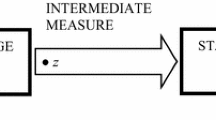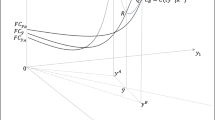Abstract
In this study, a data envelopment analysis-based approach is proposed for estimating and decomposing the potential gains from the horizontal integrations of two-stage production systems. In the first tier, the gains of the potential merger are measured by a composite efficiency index. The potential efficiency gains are then decomposed as the product of coordination efficiency and two divisional potential efficiency gains. In the second tier, the divisional potential efficiency gains are decomposed into scope, size, and learning efficiencies. We develop a multiplicative framework for decomposing potential efficiency gain in mergers of the two-stage production systems, and the coordination efficiency is considered. In the case study of commercial banks in mainland China, we develop an algorithm for estimating and decomposing potential efficiency gain for a two-stage bank production system.






Similar content being viewed by others
References
Afsharian, M., & Ahn, H. (2014). The Luenberger indicator and directions of measurement: A bottoms-up approach with an empirical illustration to German savings banks. International Journal of Production Research,52(20), 6216–6233.
Amin, G. R., & Al-Muharrami, S. (2016). A new inverse data envelopment analysis model for mergers with negative data. IMA Journal of Management Mathematics,29(2), 137–149.
An, Q., Yan, H., Wu, J., & Liang, L. (2016). Internal resource waste and centralization degree in two-stage systems: An efficiency analysis. Omega,61, 89–99.
Andersen, P., & Petersen, N. C. (1993). A procedure for ranking efficient units in data envelopment analysis. Management Science,39(10), 1261–1264.
Ang, S., & Chen, C.-M. (2016). Pitfalls of decomposition weights in the additive multi-stage DEA model. Omega,58, 139–153.
Banker, R. D., Chang, H., & Lee, S.-Y. (2010). Differential impact of Korean banking system reforms on bank productivity. Journal of Banking & Finance,34(7), 1450–1460.
Banker, R. D., Charnes, A., & Cooper, W. W. (1984). Some models for estimating technical and scale inefficiencies in data envelopment analysis. Management Science,30(9), 1078–1092.
Banker, R. D., & Natarajan, R. (2008). Evaluating contextual variables affecting productivity using data envelopment analysis. Operations Research,56(1), 48–58.
Bogetoft, P., & Wang, D. (2005). Estimating the potential gains from mergers. Journal of Productivity Analysis,23(2), 145–171.
Cachon, G. P. (2003). Supply chain coordination with contracts. Handbooks in Operations Research and Management Science,11, 227–339.
Charnes, A., Cooper, W. W., & Rhodes, E. (1978). Measuring the efficiency of decision making units. European Journal of Operational Research,2(6), 429–444.
Chen, X., Skully, M., & Brown, K. (2005). Banking efficiency in China: Application of DEA to pre- and post-deregulation eras: 1993–2000. China Economic Review,16(3), 229–245.
Chen, Y., Cook, W. D., Li, N., & Zhu, J. (2009). Additive efficiency decomposition in two-stage DEA. European Journal of Operational Research,196(3), 1170–1176.
Cook, W. D., Harrison, J., Imanirad, R., Rouse, P., & Zhu, J. (2013). Data envelopment analysis with nonhomogeneous DMUs. Operations Research,61(3), 666–676.
Cook, W. D., Liang, L., & Zhu, J. (2010). Measuring performance of two-stage network structures by DEA: A review and future perspective. Omega,38(6), 423–430.
Despotis, D. K., Koronakos, G., & Sotiros, D. (2016a). The “weak-link” approach to network DEA for two-stage processes. European Journal of Operational Research,254(2), 481–492.
Despotis, D. K., Sotiros, D., & Koronakos, G. (2016b). A network DEA approach for series multi-stage processes. Omega,61, 35–48.
Färe, R., Grosskopf, S., & Whittaker, G. (2007). Network DEA. In J. Zhu & W. D. Cook (Eds.), Modeling data irregularities and structural complexities in data envelopment analysis (pp. 209–240). Boston, MA: Springer.
Farrell, M. J. (1957). The measurement of productive efficiency. Journal of the Royal Statistical Society. Series A (General),120(3), 253–290.
Gattoufi, S., Amin, G. R., & Emrouznejad, A. (2014). A new inverse DEA method for merging banks. IMA Journal of Management Mathematics,25(1), 73–87.
Giannoccaro, I., & Pontrandolfo, P. (2004). Supply chain coordination by revenue sharing contracts. International Journal of Production Economics,89(2), 131–139.
Gupta, D., & Weerawat, W. (2006). Supplier–manufacturer coordination in capacitated two-stage supply chains. European Journal of Operational Research,175(1), 67–89.
Halkos, G. E., & Tzeremes, N. G. (2013). Estimating the degree of operating efficiency gains from a potential bank merger and acquisition: A DEA bootstrapped approach. Journal of Banking & Finance,37(5), 1658–1668.
Holod, D., & Lewis, H. F. (2011). Resolving the deposit dilemma: A new DEA bank efficiency model. Journal of Banking & Finance,35(11), 2801–2810.
Huang, Z., Li, S. X., & Mahajan, V. (2002). An analysis of manufacturer-retailer supply Chain coordination in cooperative advertising*. Decision Sciences,33(3), 469–494.
Kao, C. (2014). Network data envelopment analysis: A review. European Journal of Operational Research,239(1), 1–16.
Kao, C., & Hwang, S.-N. (2008). Efficiency decomposition in two-stage data envelopment analysis: An application to non-life insurance companies in Taiwan. European Journal of Operational Research,185(1), 418–429.
Kristensen, T., Bogetoft, P., & Pedersen, K. M. (2010). Potential gains from hospital mergers in Denmark. Health Care Management Science,13(4), 334–345.
Li, Y., Chen, Y., Liang, L., & Xie, J. (2012). DEA models for extended two-stage network structures. Omega,40(5), 611–618.
Li, S. X., Huang, Z., & Ashley, A. (1996). Inventory, channel coordination and bargaining in a manufacturer-retailer system. Annals of Operations Research,68(1), 47–60.
Li, F., Liang, L., Li, Y., & Emrouznejad, A. (2018). An alternative approach to decompose the potential gains from mergers. Journal of the Operational Research Society,69(11), 1793–1802.
Liang, L., Cook, W. D., & Zhu, J. (2008). DEA models for two-stage processes: Game approach and efficiency decomposition. Naval Research Logistics (NRL),55(7), 643–653.
Liang, L., Yang, F., Cook, W. D., & Zhu, J. (2006). DEA models for supply chain efficiency evaluation. Annals of Operations Research,145(1), 35–49.
Lim, S., & Zhu, J. (2016). A note on two-stage network DEA model: Frontier projection and duality. European Journal of Operational Research,248(1), 342–346.
Lozano, S., & Villa, G. (2010). DEA-based pre-merger planning tool. Journal of the Operational Research Society,61(10), 1485–1497.
Mattsson, P., & Tidanå, C. (2019). Potential efficiency effects of merging the Swedish district courts. Socio-Economic Planning Sciences,67, 58–68.
Seiford, L. M., & Zhu, J. (1999). Profitability and marketability of the top 55 U.S. commercial banks. Management Science,45(9), 1270–1288.
Shepherd, R. W. (1970). Theory of cost and production functions. Princeton: Princeton University Press.
Sherman, H. D., & Gold, F. (1985). Bank branch operating efficiency: Evaluation with data envelopment analysis. Journal of Banking & Finance,9(2), 297–315.
Shi, X., Li, Y., Emrouznejad, A., Xie, J., & Liang, L. (2017). Estimation of potential gains from bank mergers: A novel two-stage cost efficiency DEA model. Journal of the Operational Research Society,68(9), 1045–1055.
Simar, L., & Wilson, P. W. (2007). Estimation and inference in two-stage, semi-parametric models of production processes. Journal of Econometrics,136(1), 31–64.
Wang, K., Huang, W., Wu, J., & Liu, Y.-N. (2014). Efficiency measures of the Chinese commercial banking system using an additive two-stage DEA. Omega,44, 5–20.
Wu, D. D., & Birge, J. R. (2012). Serial chain merger evaluation model and application to mortgage banking. Decision Sciences,43(1), 5–36.
Wu, D. D., Zhou, Z., & Birge, J. R. (2011). Estimation of potential gains from mergers in multiple periods: A comparison of stochastic frontier analysis and Data Envelopment Analysis. Annals of Operations Research,186(1), 357–381.
Zeinodin, E., & Ghobadi, S. (2019). Merging decision-making units under inter-temporal dependence. IMA Journal of Management Mathematics. https://doi.org/10.1093/imaman/dpz005.
Zhu, J. (2004). Imprecise DEA via standard linear DEA models with a revisit to a Korean mobile telecommunication company. Operations Research,52(2), 323–329.
Zschille, M. (2015). Consolidating the water industry: An analysis of the potential gains from horizontal integration in a conditional efficiency framework. Journal of Productivity Analysis,44(1), 97–114.
Funding
Funding was provided by National Science Foundation of China (Grant No. 71701220).
Author information
Authors and Affiliations
Corresponding author
Additional information
Publisher's Note
Springer Nature remains neutral with regard to jurisdictional claims in published maps and institutional affiliations.
Appendix
Appendix
Table 4 reports the outputs orientation potential efficiency gains and their decompositions of the first 20 mergers in CRS case. We can find that the equation \( ME^{K} = CE^{K} *SCE_{1}^{K} *LE_{1}^{K} *SCE_{2}^{K} *LE_{2}^{K} \) is supported by the result of each K. Table 5 reports the outputs orientation potential efficiency gains and their decompositions of the first 20 mergers in VRS case. The equation \( ME^{K} = CE^{K} *SIE_{1}^{K} *SCE_{1}^{K} *LE_{1}^{K} *SIE_{2}^{K} *SCE_{2}^{K} *LE_{2}^{K} \) is supported by the result of each K.
Rights and permissions
About this article
Cite this article
Xie, J., Zhu, X. & Liang, L. A multiplicative method for estimating the potential gains from two-stage production system mergers. Ann Oper Res 288, 475–493 (2020). https://doi.org/10.1007/s10479-020-03530-x
Published:
Issue Date:
DOI: https://doi.org/10.1007/s10479-020-03530-x




